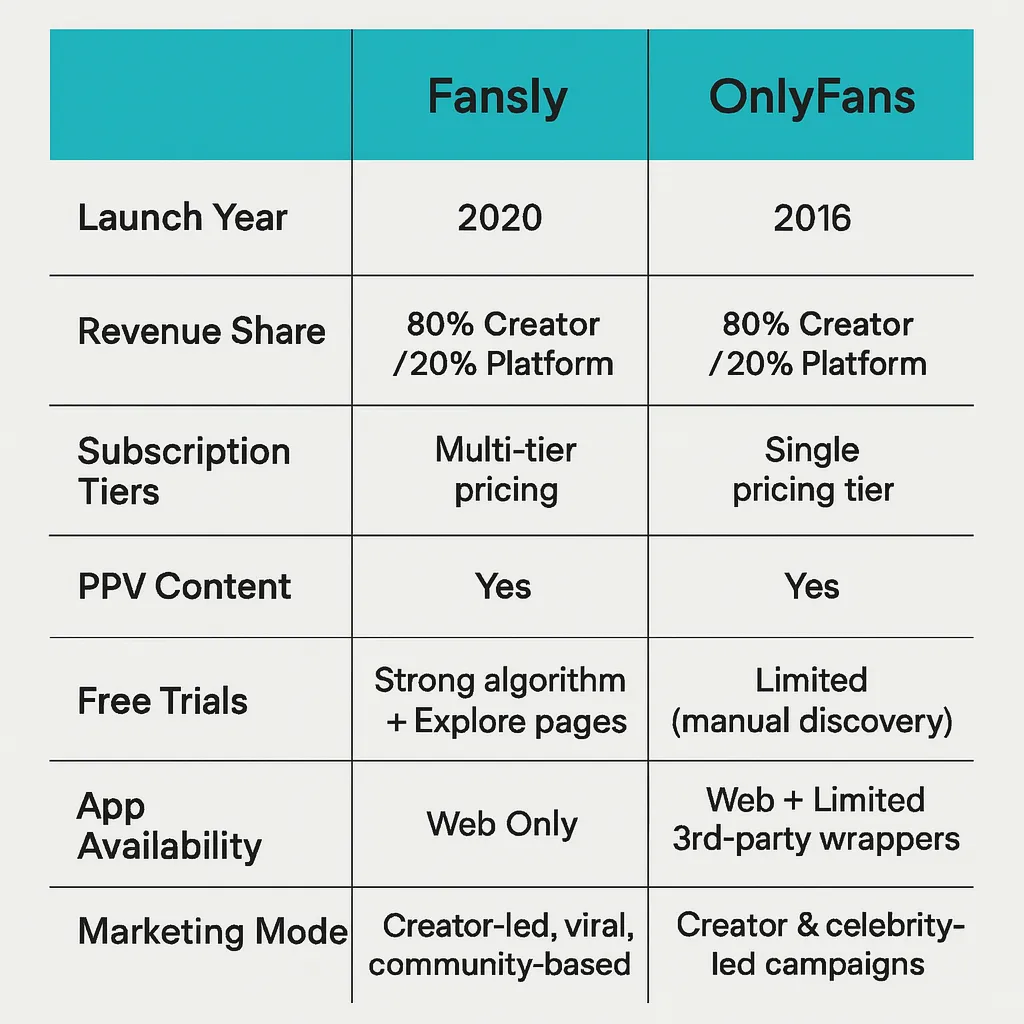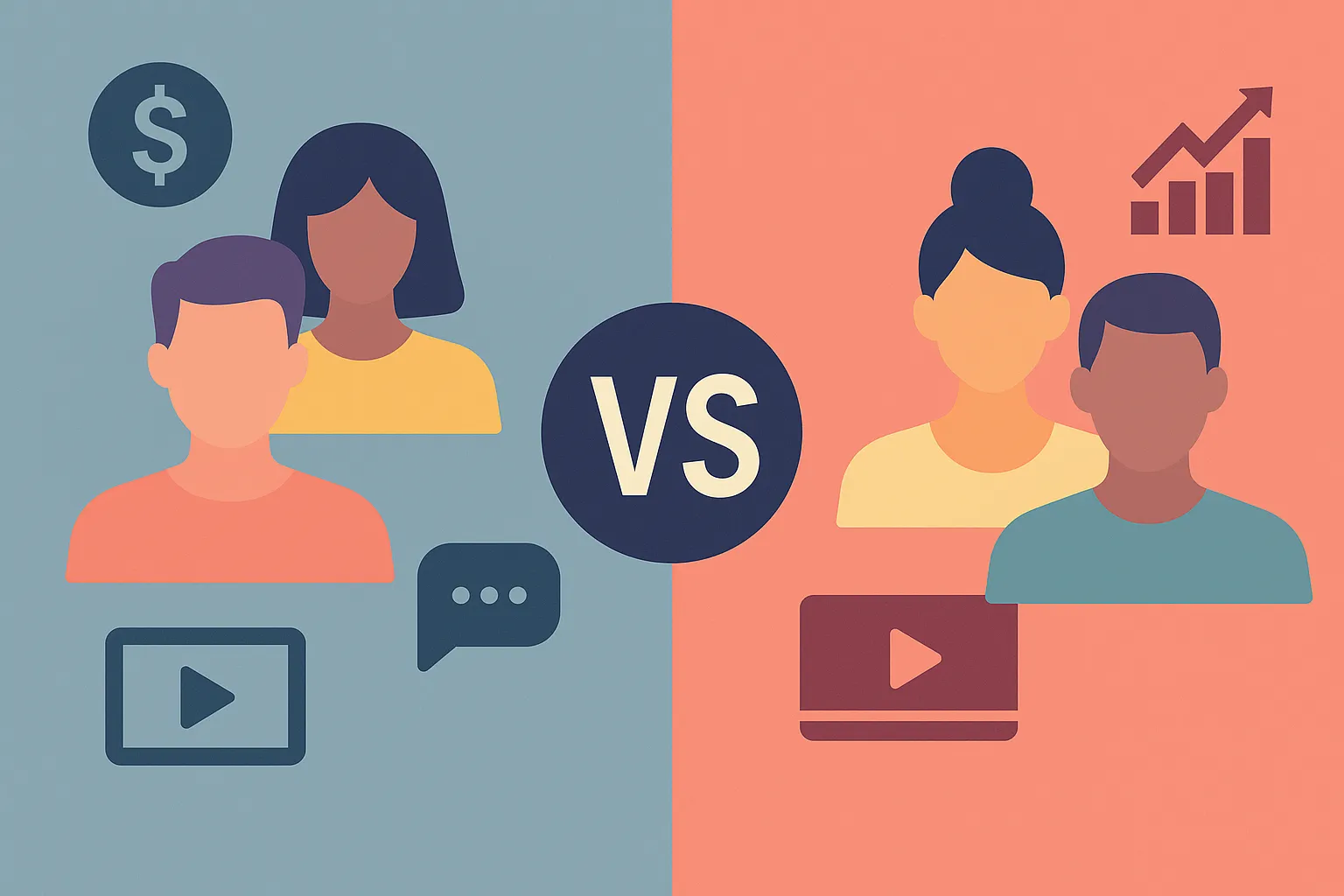As of 2025, creator monetization platforms are booming. Subscription-based models empower content creators to earn directly from fans, bypassing traditional monetization hurdles. Among the front-runners in this revolution are OnlyFans and Fansly — both widely known, yet often misunderstood in how they operate behind the scenes.
For startup founders and app entrepreneurs, choosing the right business model is crucial. The Fansly vs OnlyFans comparison isn’t just about features — it’s about revenue models, audience targeting, operational scalability, content moderation, and long-term growth potential.
This guide delivers a deep dive into the business mechanics of both platforms, empowering you with the insights needed to build your own subscription app. Whether you’re planning a Fansly clone or an OnlyFans alternative, this blog will help you make the right move.

What is Fansly?
Fansly is a content subscription platform founded in 2020 by Select Media LLC. It gained popularity as an alternative to OnlyFans, particularly during OF’s controversial ban announcement in 2021. While the decision was later reversed, the incident gave Fansly major visibility.
Fansly caters to NSFW creators, but has also welcomed fitness coaches, musicians, artists, and influencers. It differentiates itself with features like:
- Tiered subscriptions
- Free trial options
- Watermarked content
- Pay-per-message
- Follow-for-free models
Fansly became a home for creators looking for more flexibility, anonymity, and favorable discovery algorithms.
What is OnlyFans?
OnlyFans, launched in 2016 by Tim Stokely, is the pioneer of the creator subscription economy. With over 220 million users and 3+ million content creators by 2025, it’s a massive platform that allows creators to monetize:
- Photos
- Videos
- Livestreams
- Direct messages
OnlyFans rose to prominence by embracing adult content, a decision that helped it carve a niche while mainstream platforms enforced stricter content guidelines. Today, it also features non-NSFW creators from fitness, music, cooking, and education sectors.
Fansly Business Model Explained
Fansly operates on a multi-tiered subscription and commission model. Here’s a breakdown:
Revenue Streams
- Subscription Tiers (Monthly, Bi-weekly, Custom Pricing)
- Pay-Per-View (PPV) Content
- Tips & Donations
- Messaging Paywalls
- Affiliate Program
Fansly charges a 20% commission on all earnings, with creators retaining 80%.
Cost Structure
- Infrastructure: Hosting high-res media & bandwidth
- Moderation & Compliance: Ensuring age verification & legal content
- Payment Gateway Fees
- Marketing & Creator Acquisition
- Customer Support
Key Partners
- Payment Processors (CCBill, Segpay)
- Content Moderation Tools
- Cloud Providers
- Affiliate Marketers
Growth Engine
- Viral TikTok & Reddit campaigns
- Creator-friendly reputation
- Streamlined onboarding for niche creators
- Focus on personalization & privacy controls
Learn More: Business Model of Fansly: How It Makes Millions
OnlyFans Business Model Explained
OnlyFans utilizes a direct-to-fan subscription model with additional revenue from PPV content.
Revenue Streams
- Monthly Subscriptions
- Tips (during livestreams & posts)
- PPV Messaging & Locked Content
- Referral Bonuses (5% of referred creators’ earnings for 12 months)
Like Fansly, OnlyFans takes 20% commission, leaving 80% for creators.
Cost Structure
- Infrastructure & CDN Costs
- Content Review & Compliance Teams
- Legal & Security Teams
- Creator Payout Systems
- Brand Partnerships & PR
Key Partners
- Payment Processors (including mainstream & crypto options)
- Cloudflare and other CDN providers
- Legal compliance agencies (for KYC/AML)
- Influencer networks
Growth Engine
- Early adoption of adult content niche
- High-profile creator campaigns (e.g. Cardi B, Bella Thorne)
- Scalable affiliate systems
- SEO dominance for NSFW keywords
Learn More: How does OnlyFans Business Model Works & Monetization Explained
Fansly vs OnlyFans: Comparison Table
| Feature / Metric | Fansly | OnlyFans |
|---|---|---|
| Launch Year | 2020 | 2016 |
| Revenue Share | 80% Creator / 20% Platform | 80% Creator / 20% Platform |
| Subscription Tiers | Multi-tier pricing | Single pricing tier |
| PPV Content | Yes | Yes |
| Free Trials | Yes | No (limited) |
| User Discovery | Strong algorithm + Explore pages | Limited (manual discovery) |
| App Availability | Web Only | Web + Limited 3rd-party wrappers |
| Brand Perception | Flexible, growing, privacy-focused | Mature, mainstream, sometimes stigmatized |
| Content Guidelines | Adult-inclusive | Adult-inclusive |
| Marketing Model | Creator-led, viral, community-based | Creator & celebrity-led campaigns |
Pros & Cons of Fansly Business Model
Pros
- Multi-tier pricing offers flexibility for creators.
- Better content discovery algorithms for niche creators.
- Watermarking and anti-screenshot features for content protection.
- More accessible for new or anonymous creators.
- Easier viral growth via TikTok & Reddit.
Cons
- Smaller overall user base vs OnlyFans.
- No official mobile app due to content restrictions.
- Limited brand recognition outside NSFW communities.
Pros & Cons of OnlyFans Business Model
Pros
- Huge existing audience and brand power.
- Broad category of creators – adult, fitness, music, cooking.
- Reliable, mature payment systems and global reach.
- Media-backed credibility (Forbes, Bloomberg coverage).
Cons
- Discovery is hard for smaller creators.
- Past backlash from trying to ban adult content.
- Limited personalization in pricing and subscriptions.
- More saturated market for new entrants.
Market Data: Growth, Revenue, Funding
| Metric | Fansly | OnlyFans |
|---|---|---|
| User Base (2025) | 20M+ users | 220M+ users |
| Creator Base | 1M+ | 3M+ |
| Estimated 2024 Revenue | ~$150M | $2.3B+ |
| Funding | Bootstrapped | Bootstrapped |
| Platform Growth (YoY) | ~30–40% | ~10–15% |
| Profitability | Marginally profitable | Highly profitable |
Which Model is Better for Startups in 2025?
The choice between Fansly and OnlyFans business models depends on your target market, brand positioning, and feature innovation goals.
- Fansly’s model is better suited for niche creators, privacy-conscious users, and platforms with discovery-first design.
- OnlyFans’ model is ideal if you’re targeting scale, media traction, and celebrity partnerships.
Choose Fansly-style if…
You’re building a:
- Niche creator platform with advanced subscription customization
- Anonymous or privacy-first environment
- Community-focused discovery model
- App focused on young, Gen Z creators
- TikTok/Reddit-powered virality engine
Explore: Fansly Clone App Development by Miracuves
Choose OnlyFans-style if…
You’re building a:
- Celebrity-backed subscription model
- Broad category platform (fitness, cooking, etc.)
- Mature, high-volume traffic system
- Platform built for global payment scalability
Explore: OnlyFans Clone App Development by Miracuves
Conclusion
In the fast-growing creator economy, there’s no single winner — both Fansly and OnlyFans have strong, proven models.
However, for 2025 and beyond, personalization, discovery, and creator autonomy will be key. Fansly’s model edges forward in flexibility and growth potential for niche markets. That said, OnlyFans’ proven revenue strength can’t be ignored for platforms looking to scale quickly.
At Miracuves, we help entrepreneurs build creator-first platforms tailored to your goals — whether you’re aiming for a Fansly-style discovery engine or an OnlyFans-style juggernaut. From backend development to marketing integrations, we’ve got you covered.
FAQs
1. What’s the primary difference between Fansly and OnlyFans business models?
Fansly offers more customization in pricing tiers and discovery tools, while OnlyFans focuses on scale and mainstream adoption.
2. How do both platforms make money?
Both take a 20% cut from creator earnings through subscriptions, PPV content, and tips.
3. Which platform is better for new creators?
Fansly offers better discoverability and flexibility, making it ideal for new or niche creators.
4. Can I build a subscription platform like Fansly or OnlyFans?
Yes! With Miracuves’ ready-made clone scripts and custom development, you can launch your own platform affordably.
5. Is adult content mandatory on these platforms?
No. While both support adult creators, they also host fitness, music, education, and lifestyle creators.








